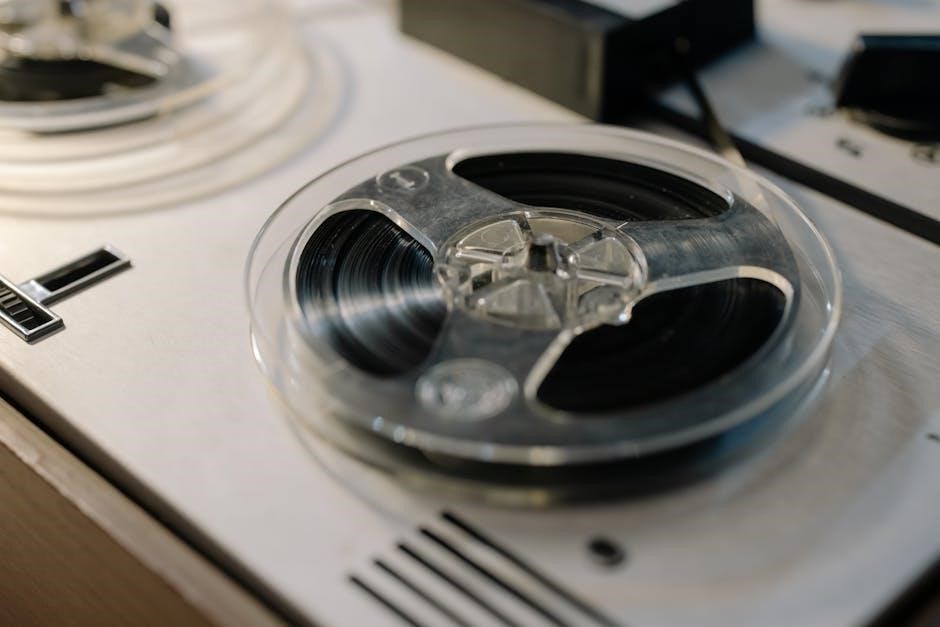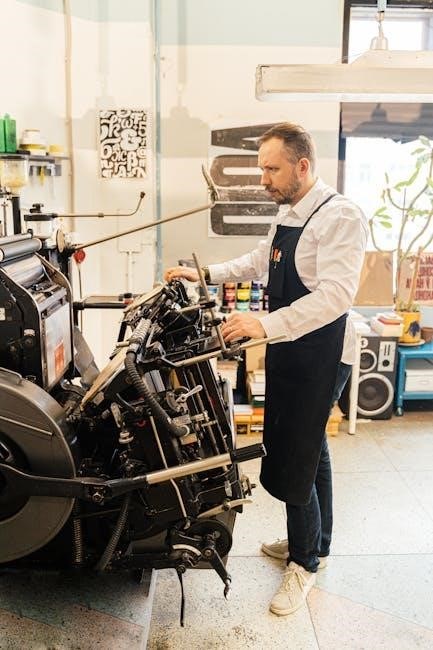Panasonic Bread Machine Instruction Manual: A Comprehensive Guide
Welcome! This manual details operation for Panasonic bread machines like the SD-R2550, SD-YR2540, and others․
Discover baking secrets, from basic loaves to sourdough, jam, and pizza dough!
Explore pre-set programs, troubleshooting, and maintenance for consistently delicious, bakery-style results․ Enjoy fresh bread easily!
Panasonic has long been a leader in automatic bread making, offering a range of models from the basic SD-R2550 to advanced machines like the SD-ZX2522KXC and newer series (SD-YR2540, SD-YR2550, SD-R2530, SD-B2510)․ These machines simplify baking, delivering consistent results for both novice and experienced bakers․
Their popularity stems from features like pre-set programs – offering options for white, whole wheat, sweet breads, and more – alongside innovative technologies like advanced temperature sensors․ Panasonic bread makers aim to replicate traditional baking methods with convenience․ Whether you’re seeking a simple loaf or exploring gluten-free options, a Panasonic machine provides a versatile solution for fresh, homemade bread․
Understanding Your Model: SD-R2550 & Beyond
The SD-R2550 serves as a foundational model, boasting 20 pre-set programs and an advanced temperature sensor for consistent baking․ Newer models, like the SD-YR2540 and SD-YR2550, expand program offerings to 32 and 31 respectively, including options for brioche and jams․
The SD-ZX2522KXC introduces sourdough functionality, while the SD-B2510 provides 21 programs․ Key differences lie in program variety and design refinements․ All models share core features, but understanding your specific machine’s capabilities is crucial for optimal results․ Refer to your model’s manual for detailed program lists and specific instructions․
Key Features Across Panasonic Models
Panasonic bread machines consistently deliver versatility․ A hallmark is the advanced temperature sensor, ensuring optimal baking conditions․ Many models, including the SD-R2550, feature 20 pre-set programs for diverse breads, cakes, and pizza dough․
The convenient raisin and nut dispenser automatically adds ingredients at the perfect time․ Newer models introduce a “bread mix preset” function, streamlining recipes․ Despite design updates for space-saving, core functionality remains focused on ease of use and consistently delicious results, making homemade baking accessible to all skill levels․

20 Pre-set Baking Programs (SD-R2550)
The SD-R2550 boasts 20 pre-set programs, offering exceptional baking flexibility․ These programs cover a wide range, from basic white bread and whole wheat to sweet breads and even pizza dough․ Users can effortlessly create various textures and flavors with minimal effort․
These automated settings simplify the baking process, ensuring consistent results․ The programs intelligently control kneading, rising, and baking times․ This feature is ideal for both novice and experienced bakers seeking convenience and reliability in their bread-making endeavors, delivering bakery-style loaves every time․
Advanced Temperature Sensor Technology
Panasonic bread machines utilize advanced temperature sensor technology for precise baking control․ This innovative feature continuously monitors and adjusts the internal temperature throughout the baking cycle․ It ensures optimal yeast activation, dough development, and a perfectly baked loaf․
The sensor compensates for ambient temperature variations, guaranteeing consistent results regardless of kitchen conditions․ This technology minimizes the risk of underbaked or overbaked bread, delivering consistently delicious outcomes․ It’s a key component in achieving professional-quality bread in the comfort of your home․
Raisin and Nut Dispenser Functionality

Panasonic bread machines, like the SD-R2550, often feature a convenient raisin and nut dispenser․ This automated system allows you to add ingredients at the optimal moment during the kneading cycle․ It prevents crushing or premature mixing, ensuring even distribution throughout the loaf․

Simply place your desired additions – raisins, nuts, seeds, or chocolate chips – into the dispenser before starting the baking process․ The machine will automatically release them at the appropriate time, creating a delightful texture and flavor in every slice․ Enjoy customized bread effortlessly!
Setting Up Your Bread Machine
Before your first bake, carefully unpack your Panasonic bread machine and remove all packaging materials․ Thoroughly clean the bread pan, kneading blade, and sensor with warm, soapy water․ Ensure all components are completely dry before reassembling․
Place the machine on a stable, level surface away from heat sources․ Familiarize yourself with the component identification – bread pan, kneading blade, sensor, and control panel․ Proper setup is crucial for optimal performance and consistent baking results․ Refer to your model’s specific diagram for clarity․
Initial Setup and Cleaning
Prior to the first use, unpack your Panasonic bread machine and remove all protective materials․ Wash the bread pan and kneading blade with warm, soapy water; ensure they are completely dry․ Wipe down the machine’s exterior with a damp cloth․
A gentle cleaning cycle can be run without ingredients to eliminate any manufacturing residue․ This initial cleaning ensures a fresh start for your baking endeavors․ Always unplug the machine before cleaning․ Proper initial setup guarantees optimal performance and delicious, worry-free baking experiences from the very beginning!
Component Identification
Familiarize yourself with your Panasonic bread machine’s parts․ Key components include the bread pan, kneading blade, and the main unit housing the heating element and controls; Locate the ingredient dispenser (if equipped), often for raisins or nuts․
Understand the control panel – buttons for program selection, crust color, start/stop, and timer functions․ The advanced temperature sensor is internal․ Refer to your model’s specific diagram for precise locations․ Knowing each part ensures proper assembly, operation, and maintenance for consistently perfect loaves․
Basic Bread Making: A Step-by-Step Guide
Begin by adding liquids first, then dry ingredients – flour, sugar, and salt – to the bread pan․ Crucially, create a small well for the yeast, keeping it separate from the salt initially․ This prevents premature activation․
Secure the bread pan and kneading blade․ Select the appropriate program (White Bread is a good starting point) and crust color․ Press ‘Start’․ Monitor the initial mixing stage․ Remember, ingredient order and accurate measurements are vital for successful bread making with your Panasonic machine!
Ingredient Measurement and Order
Accuracy is key! Always use measuring cups and spoons specifically designed for baking․ Liquids should be measured in liquid measuring cups, and dry ingredients leveled off․ Begin with liquids – water, milk, oil – directly into the bread pan․
Next, add dry ingredients: flour, sugar, and salt․ Crucially, create a small well in the flour for the yeast․ This prevents direct contact with the salt, which can inhibit activation․ Finally, add any optional ingredients like seeds or herbs․ Follow recipe instructions precisely for best results!
Yeast Activation and Considerations
Yeast is vital! Ensure your yeast is fresh; expired yeast won’t activate properly, resulting in a failed loaf․ Instant or bread machine yeast can be added directly to the dry ingredients․ Active dry yeast may require proofing – dissolving in warm water (105-115°F) with a pinch of sugar – for 5-10 minutes until foamy․
Avoid using water that’s too hot, as it can kill the yeast․ Salt inhibits yeast activity, so don’t let it come into direct contact․ Humidity and temperature affect rising times; adjust accordingly for optimal results․
Utilizing Pre-set Programs
Panasonic bread machines offer convenience! The SD-R2550 boasts 20 pre-set programs, while newer models like the SD-YR2540 offer up to 32․ These programs automate baking for various bread types – White, Whole Wheat, Sweet, French, and more․ Simply select the desired program, add ingredients in the specified order, and press start․
Each program adjusts baking time, kneading speed, and temperature for optimal results․ Explore programs for pizza dough, cake, or even jam! Refer to your model’s manual for specific program details and ingredient recommendations․

Whole Wheat Bread Program
The Whole Wheat program is designed for denser, nutritious loaves․ Use 100% whole wheat flour, or a blend for a lighter texture․ Typically, this program features a longer kneading and rising time to fully develop gluten in the whole wheat flour․
Ensure proper hydration, as whole wheat absorbs more liquid․ A slightly wetter dough is often beneficial․ Refer to your machine’s manual for specific flour and liquid ratios․ Experiment with adding vital wheat gluten for improved rise and texture․ Enjoy a hearty, wholesome loaf!
White Bread Program
The White Bread program is ideal for classic, soft-crusted loaves․ Utilize bread flour for optimal gluten development and structure․ This program generally involves a standard kneading and rising cycle, resulting in a lighter, airier texture compared to whole wheat․

Precise ingredient measurement is crucial for consistent results․ Ensure yeast is fresh and properly activated․ Adjust liquid levels slightly based on flour type and humidity․ This program is a great starting point for beginners, delivering reliable, delicious white bread every time!
Sweet Bread Program
The Sweet Bread program is specifically designed for enriched doughs containing sugar, butter, and often eggs․ This program features a longer, gentler kneading cycle to properly incorporate these ingredients, resulting in a tender crumb․ Use bread flour for structure, but be mindful of sugar content, as excessive sugar can inhibit yeast activity․
This program excels at creating brioche, challah, or sweet rolls․ Monitor the dough during the initial kneading phase; adjust liquid if needed․ Expect a slightly longer baking time to ensure thorough cooking and a golden-brown crust․
Advanced Baking Options
Panasonic bread machines offer versatility beyond basic loaves․ Explore Gluten-Free Baking with dedicated programs and appropriate flour blends for those with dietary restrictions․ The Cake and Pizza Dough Programs provide pre-set cycles for these treats, simplifying preparation․
Additionally, utilize the Jam and Dough Making Programs – perfect for homemade preserves or preparing dough for pastries․ Experiment with custom recipes, adjusting baking times and crust colors․ Newer models, like the SD-YR2540, expand these options with even more specialized programs․
Gluten-Free Baking
Panasonic bread machines, like the SD-R2550, feature a dedicated Gluten-Free Program․ Success relies on using a quality gluten-free flour blend, often containing starches and gums to mimic gluten’s structure․
Ensure the blend is specifically designed for bread machines․ You may need to adjust liquid levels slightly, as gluten-free flours absorb moisture differently․ The program optimizes kneading and rising times for gluten-free doughs, which typically require less development․ Expect a slightly denser loaf compared to traditional wheat bread․
Cake and Pizza Dough Programs
Panasonic bread machines offer versatile programs beyond bread! The Cake Program is ideal for sweet, quick breads and even cheesecakes, providing a gentle mixing and baking cycle․ The Pizza Dough Program expertly kneads and proofs dough for homemade pizzas, ensuring a perfectly textured crust․
For cake, reduce sugar slightly from traditional recipes․ Pizza dough benefits from a longer proofing time for enhanced flavor․ Remember to adjust ingredient quantities based on your machine’s capacity and desired outcome․ Enjoy fresh, homemade treats!
Jam and Dough Making Programs
Panasonic bread machines excel beyond baking with dedicated Jam and Dough Making programs․ The Jam Program allows you to create delicious, preservative-free fruit spreads using fresh or frozen fruit and sugar – a delightful homemade treat! The Dough Making Program is perfect for preparing dough for pastries, cookies, or even pasta, saving you time and effort․
For best jam results, use fruits with high pectin content․ Dough programs offer varying kneading and rising times; select the appropriate setting for your recipe․ Enjoy the convenience of homemade goodness!
Customizing Your Bread Recipes
Panasonic bread machines offer flexibility beyond pre-set programs․ Adjusting Baking Time allows for personalized loaves – increase for larger recipes or denser textures, decrease for softer results․ Crust Color Control lets you choose from light, medium, or dark crusts, tailoring the loaf to your preference․
Experiment with ingredient ratios, adding seeds, herbs, or different flours․ Remember that adjustments may require slight alterations to liquid levels․ Keep detailed notes of your modifications for consistent, customized baking!
Adjusting Baking Time
Panasonic bread machines allow Adjusting Baking Time for personalized results․ Increase time (in 10-minute increments) for larger recipes, higher hydration doughs, or a denser loaf․ Conversely, decrease time for softer bread, but avoid excessive reduction, which can lead to underbaked results․
Monitor the dough during the initial kneading phase; if it seems too wet or dry, adjust liquid or flour accordingly before the baking cycle begins․ Careful observation and small adjustments are key to perfecting your recipes!
Crust Color Control
Panasonic bread machines offer Crust Color Control, typically with options ranging from Light, Medium, to Dark․ Selecting a darker setting extends baking time slightly, resulting in a richer, more deeply browned crust․ A lighter setting reduces baking time for a paler crust․
Experiment to find your preferred shade! Consider the recipe; sweeter breads often benefit from a lighter crust, while hearty whole wheat loaves pair well with a darker one․ Remember, humidity and ingredient variations can influence the final result․
Troubleshooting Common Issues

Lumpy loaves are a frequent concern; often caused by improper ingredient measurement, particularly yeast․ Ensure accurate measurements and check yeast expiration dates․ Yeast not activating can stem from water temperature – it should be lukewarm (around 105-115°F)․
Also, avoid direct contact between yeast and salt․ If the machine displays an error code, consult the ‘Understanding Error Codes’ section․ A collapsed loaf might indicate too much liquid or insufficient gluten development․ Consistent issues warrant reviewing the recipe and machine maintenance․
Lumpy Loaves and Causes
Lumpy loaves are a common issue with Panasonic bread machines, often stemming from uneven ingredient distribution or improper mixing․ Insufficient kneading can leave pockets of dry flour․ Ensure accurate ingredient measurements, especially flour and liquids․
Yeast distribution is crucial; ensure it’s evenly dispersed․ Sometimes, the machine’s kneading paddle doesn’t reach all areas of the pan․ Reviewing the recipe and verifying ingredient quality can help․ A Panasonic review noted lumpy loaves as a potential drawback․
Yeast Not Activating
Yeast failing to activate results in flat, dense bread․ Expired yeast is a primary cause; check the expiration date! Water temperature is critical – too hot kills yeast, too cold hinders activation․ Aim for 105-115°F (40-46°C)․
Sugar provides food for the yeast; ensure sufficient quantity․ Salt can inhibit yeast if added directly; add it away from the yeast․ Verify your yeast is a fresh, active dry or instant variety․ Proper activation is fundamental for a successful rise and airy texture․
Cleaning and Maintenance
Regular cleaning ensures optimal performance and longevity of your Panasonic bread machine․ Always unplug the machine before cleaning․ The bread pan and kneading blade are removable and dishwasher-safe, or wash with warm, soapy water․
Wipe the exterior with a damp cloth; avoid abrasive cleaners․ Ensure the sensor is clean and dry․ Thoroughly dry all components before reassembling․ Consistent maintenance prevents buildup and ensures consistently delicious results․ Inspect the power cord regularly for damage․
Cleaning the Bread Pan
Proper cleaning of the bread pan is crucial․ After each use, remove the pan and kneading blade promptly․ The non-stick coating requires gentle handling; avoid abrasive scrubbers․ You can wash the bread pan and blade with warm, soapy water, or place them in the dishwasher for convenience․
Ensure all residue is removed to prevent sticking in future bakes․ Thoroughly dry both components before reinserting them into the machine․ A clean bread pan guarantees optimal loaf release and prevents unwanted flavors․
Exterior Cleaning and Care
Maintaining the exterior of your Panasonic bread machine is simple․ Always disconnect the appliance from the power outlet before cleaning․ Wipe down the machine’s exterior with a soft, damp cloth․ Avoid using harsh chemicals or abrasive cleaners, as these can damage the finish․
For stubborn stains, a mild detergent solution can be used, followed by a clean, damp wipe․ Ensure no moisture enters the machine’s internal components․ Regular exterior cleaning keeps your bread machine looking its best and ensures longevity․
Understanding Error Codes
Error codes displayed on your Panasonic bread machine indicate specific issues․ While models vary, common codes signal problems like power failures or sensor malfunctions․ A code might indicate an issue with the heating element, temperature sensor, or lid closure․

Consult your model’s specific manual for a complete list and troubleshooting steps․ Often, simply restarting the machine resolves minor errors․ If an error persists, contact Panasonic support for assistance․ Ignoring error codes can lead to further damage or inconsistent baking results․
Common Error Code Meanings
Error code E01 often signals a power interruption during the baking cycle, requiring a restart․ E02 may indicate a faulty temperature sensor, potentially needing professional repair․ E03 suggests a lid closure issue – ensure it’s securely fastened․ E04 can mean the kneading blade is obstructed, or the motor is overloaded․

E05 frequently points to a heating element malfunction․ Always refer to your specific model’s manual for precise definitions․ These are general guidelines; accurate diagnosis requires referencing the correct documentation․ Contact Panasonic support if codes persist after troubleshooting․
Exploring Newer Models: SD-YR2540, SD-YR2550, SD-R2530, SD-B2510
Panasonic’s recent line-up offers varied program counts: the SD-YR2540 boasts 32, the SD-YR2550 has 31, the SD-R2530 features 30, and the SD-B2510 provides 21․ These models maintain the core functionality of authentic bread baking, alongside options for pizza dough, brioche, cakes, and jams․
A key addition is the “Bread Mix Preset” function, streamlining recipes using pre-made mixes․ While earlier models covered mix usage in manuals, this feature simplifies the process․ Design updates aim for space-saving profiles, though effectiveness varies․
Program Differences Between Models
The SD-YR2540 and SD-YR2550 offer the most extensive program selections, with 32 and 31 presets respectively, catering to diverse baking needs․ The SD-R2530 provides a slightly reduced, yet still comprehensive, 30 programs․ The SD-B2510, positioned as a more basic option, includes 21 programs․
These variations primarily affect specialty bread types, cake options, and dough settings․ Newer models generally expand upon whole wheat and sourdough capabilities․ The core programs – white bread, basic bread – remain consistent across the range, ensuring reliable results for everyday baking;
Bread Mix Preset Function Explained
Panasonic’s bread mix preset function isn’t a new feature, but a refined setting optimizing baking with pre-made bread mixes․ Existing manuals already detail bread mix usage, so this update likely enhances the process․ It automatically adjusts kneading, rising, and baking times for optimal results with various mix types․
This function simplifies baking for beginners and ensures consistent outcomes․ It removes guesswork, delivering perfectly baked loaves using convenient bread mixes․ Users should still consult the mix’s instructions alongside the machine’s preset for best results․
Sourdough Baking with Panasonic Machines (SD-ZX2522KXC)
The SD-ZX2522KXC model introduces a dedicated sourdough program, catering to the growing popularity of artisan bread․ This program meticulously controls fermentation and proofing, crucial for developing sourdough’s characteristic tang and texture․ It allows for both starter maintenance and full loaf baking within the machine․
Users can customize hydration levels and fermentation times to suit their starter’s activity․ The program aims to replicate traditional sourdough techniques, offering convenience without compromising quality․ Experimentation is encouraged to achieve desired flavor profiles and crust characteristics․
Comparing Panasonic Models: SD-ZX2522 vs․ Newer Options
The SD-ZX2522 remains a highly regarded model, particularly for its sourdough capabilities․ Newer machines like the SD-YR2540/2550 offer updated designs and a “bread mix preset” function, potentially streamlining recipes․ However, the core functionality remains similar across the range․
Newer models boast a greater number of pre-set programs (up to 32), while the SD-ZX2522 features a more focused selection․ The decision hinges on individual needs; if sourdough is paramount, the SD-ZX2522 excels․ Otherwise, newer models provide broader versatility․

Safety Precautions
Always ensure the bread machine is placed on a stable, heat-resistant surface, away from flammable materials․ Never immerse the appliance in water or any other liquid․ Do not operate with a damaged cord or plug․ Unplug before cleaning or when not in use․
Caution: The bread pan and heating element become extremely hot during operation․ Use oven mitts when handling․ Avoid touching moving parts․ Keep children away during operation․ Never attempt to repair the machine yourself; contact authorized service personnel for assistance․
Warranty Information
Panasonic offers a limited warranty on its bread machines, covering defects in materials and workmanship․ The standard warranty period is typically one year from the date of purchase․ Please retain your proof of purchase for warranty claims․ This warranty does not cover damage resulting from misuse, accidents, or unauthorized repairs․
To initiate a warranty claim, contact Panasonic’s customer support or visit their website for detailed instructions․ Warranty service may require returning the unit for inspection or repair․ Extended warranties may be available for purchase․
Resources and Support
For additional assistance with your Panasonic bread machine, several resources are available․ The official Panasonic website offers downloadable manuals, FAQs, and troubleshooting guides․ Reddit’s r/BreadMachines community provides a forum for users to share tips, recipes, and solutions to common issues․
Amazon product pages often feature customer reviews and Q&A sections․ Panasonic’s customer support team can be reached via phone or email for direct assistance․ Explore online recipe websites and baking blogs for inspiration and new bread-making ideas!
